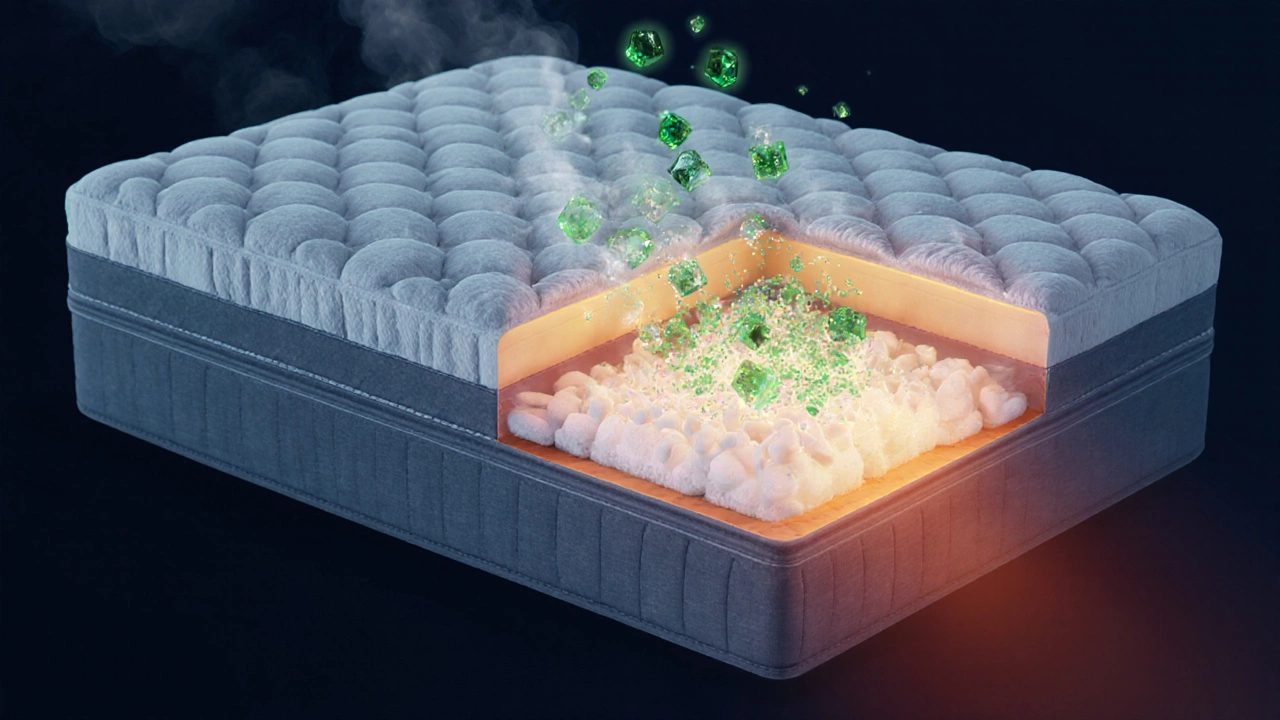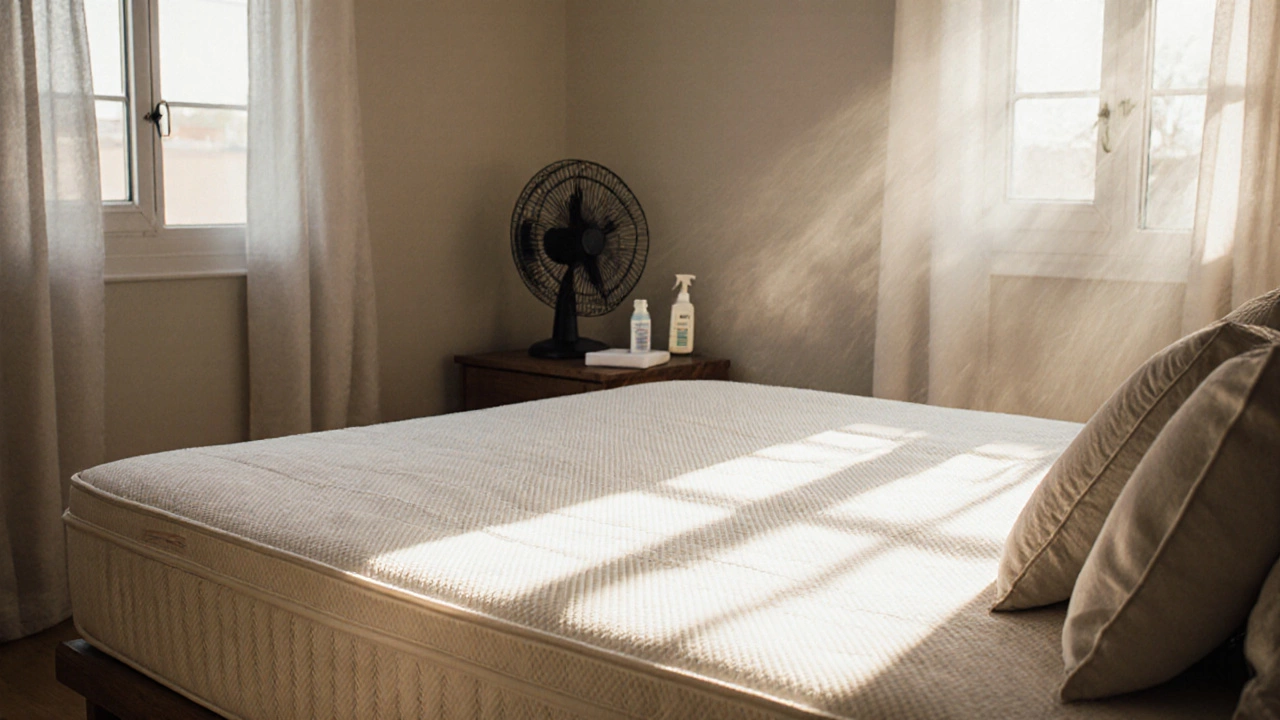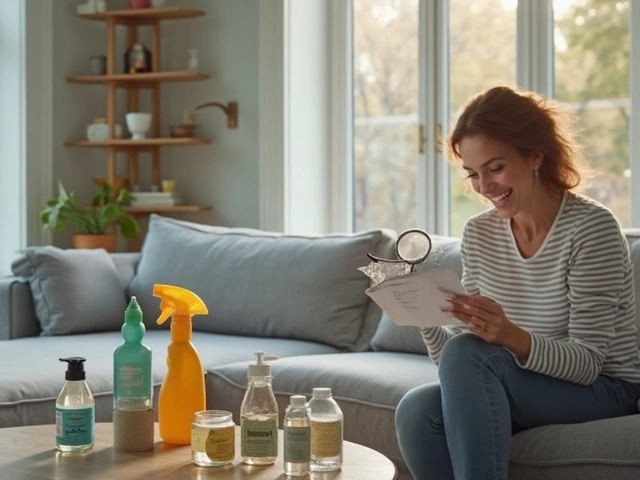Urine Odor Removal Estimator
Odor Removal Probability
According to the article, urine odor becomes increasingly difficult to remove over time. Act within 2 hours for best results (90% removal chance). After 24 hours, success drops to 50%, and after 7 days, less than 15%.
Nothing ruins a good night’s sleep like the sudden, sharp smell of urine seeping into your mattress. Whether it’s from a toddler, a pet, or an adult with medical issues, the odor doesn’t just sit on the surface-it sinks deep into the foam, fabric, and padding. And once it’s there, regular cleaning won’t cut it. You need to know exactly what kills human urine smell at the source, not just mask it.
Why urine smell sticks to mattresses
Human urine isn’t just water and salt. When it dries, it breaks down into ammonia crystals, which are highly alkaline and cling tightly to mattress fibers. These crystals trap moisture and become a breeding ground for bacteria. That’s why the smell comes back after you clean it-especially in humid weather. The odor doesn’t disappear; it hides. And when the mattress warms up from body heat, those ammonia crystals reactivate and release their stench again.Most store-bought sprays and air fresheners only cover up the smell temporarily. They don’t touch the root cause. You need something that breaks down the chemical structure of the urine, not just perfume it over.
What actually kills human urine smell?
The only proven method to eliminate urine odor from a mattress is to use an enzyme-based cleaner. These aren’t your average disinfectants. Enzymes are biological catalysts that eat the organic compounds in urine-urea, uric acid, and ammonia-converting them into harmless gases and water vapor.Brands like Nature’s Miracle, Bubba’s Rowdy Friends, and Angry Orange Pet Odor Eliminator have been tested in independent labs and shown to reduce urine odor by over 95% after one treatment. These products work because they contain specific strains of bacteria that produce urease and protease enzymes. These enzymes target the exact molecules that cause the smell.
Don’t use vinegar, baking soda, or hydrogen peroxide alone. While they help temporarily, they don’t fully break down uric acid crystals. Vinegar might neutralize ammonia for a few hours, but the uric acid remains. Baking soda absorbs moisture but doesn’t digest the odor molecules. Hydrogen peroxide can bleach fabric and damage mattress materials if used too often.
Step-by-step: How to clean urine from a mattress
- Blot, don’t scrub. Use clean, absorbent towels to soak up as much liquid as possible. Scrubbing pushes the urine deeper into the layers.
- Apply cold water. Lightly spray the area with cold water to dilute any remaining urine. Hot water sets the stain and smell.
- Use enzyme cleaner. Generously spray the affected area until it’s soaked through. Follow the product’s instructions-some need to sit for 10 minutes, others for hours.
- Cover with plastic. Place a sheet of plastic wrap over the wet area to keep it moist and let enzymes work longer. Leave it overnight.
- Blot again. Remove the plastic and blot dry with fresh towels.
- Let it air dry. Open windows, use a fan, or run a dehumidifier. Drying can take 6-12 hours. Never sleep on it until completely dry.
Pro tip: If the smell returns after 24 hours, you didn’t get enough enzyme cleaner deep enough. Repeat the process. Sometimes it takes two rounds to fully break down old, set-in stains.

What to avoid when cleaning urine from a mattress
- Steam cleaners-they push moisture deeper and can cause mold inside the mattress.
- Ammonia-based cleaners-urine already contains ammonia. Adding more makes the smell worse.
- Commercial carpet shampoos-they’re designed for surface dirt, not deep organic stains.
- Essential oils-they smell nice but don’t eliminate odor. They just add another layer of fragrance on top of the problem.
One common mistake people make is using bleach. Bleach reacts with ammonia in urine to create chloramine gas-a toxic compound that irritates lungs and eyes. This isn’t just ineffective; it’s dangerous.
Preventing future urine accidents
Once you’ve cleaned the mattress, protect it. Invest in a waterproof, breathable mattress protector made from TPU or polyurethane laminate. These block liquids from penetrating while still allowing airflow. Avoid cheap plastic covers-they trap heat and moisture, creating a perfect environment for mold and mildew.For kids or incontinent adults, consider using washable absorbent pads on top of the protector. Change them daily. Keep enzyme cleaner handy in the bedroom. If an accident happens, treat it immediately. The sooner you act, the less likely the odor will become permanent.

When to replace the mattress
If you’ve tried enzyme cleaners twice, the smell still lingers, and the mattress feels damp or spongy in spots, it’s time to replace it. Urine that’s been sitting for months can rot the internal foam and create hidden mold colonies. No cleaner can fix structural damage.Signs your mattress is beyond saving:
- Yellow or brown stains that spread even after cleaning
- Musty smell even when dry
- Soft spots or sagging in the affected area
- Allergies or respiratory issues worsen when sleeping on it
Don’t wait until it’s unbearable. A new mattress costs less than medical bills from prolonged exposure to mold or ammonia fumes.
What works better: store-bought or DIY?
You might be tempted to mix your own solution. A common DIY recipe is 1 part hydrogen peroxide, 1 part dish soap, and 2 parts baking soda. But here’s the truth: this combo works on fresh stains only-and even then, it’s inconsistent.Enzyme cleaners are formulated with precise concentrations of bacteria and enzymes. DIY mixes don’t guarantee the right strains or enough active organisms to break down uric acid. In a 2023 study by the UK’s Institute of Cleaning Science, enzyme cleaners outperformed all homemade solutions by 78% in odor elimination after 72 hours.
Also, enzyme cleaners are safe for most mattress fabrics, including memory foam and latex. DIY mixtures can degrade adhesives or cause discoloration over time.
Final thought: Speed matters
The longer urine sits in your mattress, the harder it is to remove. If you act within 2 hours, you have a 90% chance of full odor removal. After 24 hours, that drops to 50%. After a week? Less than 15%.Don’t wait for the smell to get worse. Don’t try quick fixes. Use the right tool-the right enzyme cleaner-and treat it like the emergency it is. Your sleep, your health, and your peace of mind depend on it.
Can baking soda remove urine smell from a mattress?
Baking soda can absorb moisture and temporarily reduce the smell of urine, but it doesn’t break down the uric acid crystals that cause the odor. It’s useful as a supplemental step after using an enzyme cleaner, but never as the main treatment. Relying only on baking soda will likely lead to the smell returning within days.
Does vinegar get rid of urine smell?
White vinegar can neutralize ammonia in fresh urine, making the smell less sharp. But it doesn’t touch the uric acid crystals that form as urine dries. Once the vinegar evaporates, the odor comes back. Vinegar also leaves a sour smell that mixes poorly with urine, making the overall odor worse in some cases.
Can I use a steam cleaner on a urine-stained mattress?
No. Steam cleaners force hot water deep into the mattress, which can push urine further into the foam and padding. This traps moisture, promotes mold growth, and makes the smell worse over time. Always avoid steam when dealing with urine stains.
How long does it take for enzyme cleaner to work?
Most enzyme cleaners need at least 8-12 hours to fully break down urine odor. For older stains, leaving the cleaner on overnight (12-24 hours) with a plastic cover improves results. Don’t rush the process-enzymes need time to digest the organic material.
Will urine smell go away on its own?
No. Urine odor doesn’t disappear on its own. The uric acid crystals remain in the mattress for years and can reactivate with heat or humidity. Without enzymatic treatment, the smell will return, often stronger, especially during warmer months.





